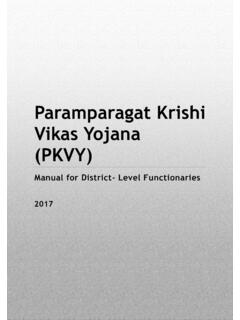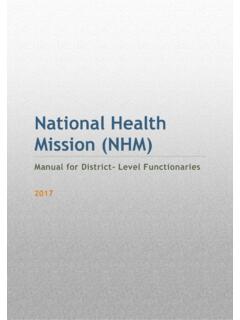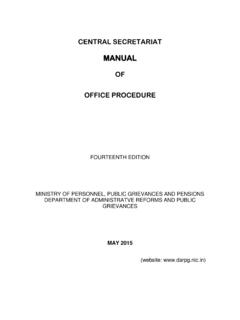Transcription of FLOOD EARLY WARNING SYSTEM -A WARNING MECHANISM …
1 FLOOD EARLY WARNING SYSTEM . -A WARNING MECHANISM FOR. MITIGATING DISASTERS DURING FLOOD . DOCUMENT SUPPORTED BY. DEPARTMENT OF ADMINISTRATIVE REFORMS & PUBLIC GRIEVANCES. MINISTRY OF PERSONNEL, PUBLIC GRIEVANCES & PENSIONS. GOVERNMENT OF INDIA. TABLE OF CONTENTS. CONTENTS PAGE NO. introduction 1. EARLY WARNING SYSTEM 1-5. Background 1. Key Elements of EARLY WARNING SYSTEM 2. Risk Knowledge 3. Monitoring and WARNING Services 3. Dissemination and Communication 3. Response Capability 4. FLOOD EARLY WARNING SYSTEM 4. Benefits of FLOOD EARLY WARNING Systems 5. About Assam 6-8. introduction 6. Rivers in Assam 7. The Brahmaputra River 7.
2 The Barak River 8. District-Wise FLOOD Hazard Index 9-10. FLOOD EARLY WARNING SYSTEM (FLEWS) in Assam 11-26. Statement of problem 11. Motivators of the Project 11. Purpose & Priorities of the Initiative 12. The Project 12. Major Technical Components of the Project 14. The Meteorological Component 15. The Hydrological Component 18. Generation and Dissemination of FLOOD EARLY WARNING 23. Methodology for dissemination of FLOOD WARNING alerts to 26. districts Role of different organisations/stakeholders 27-28. Assam State Disaster Management Authority (ASDMA) 27. North Eastern Space Application Centre 27. (NESAC). Central Water Commission (CWC) 28.
3 Indian Meteorological Department (IMD) 28. Assam Water Resources Department (AWRD) 28. Strategies adopted for bringing about the transformation and its impact 28. Uniqueness of the Project 28-29. Effectiveness of FLEWS 29. i Success of FLEWS 29-38. Area affected, Population affected and Human Lives lost-A 30. comparative analysis Voices from the Districts 32-38. Barpeta 32. Dhemaji 33. Goalpara 34. Nalbari 34. Lakhimpur 35. Milestones 38. Lessons Learnt 38. Conclusion 39. References 40. ii LIST OF FIGURES. FIGURE PARTICULARS PAGE NO. NO. 1 Key Elements of an EARLY WARNING SYSTEM 2. 2 Assam and its neighbouring States 6. 3 Major River Systems of Assam 9.
4 4 Districts Covered under FLEWS 13. 5 Flow chart of the overall methodology of FLEWS 14. 6 WRF Modeling SYSTEM flow chart 15. 7 Total 24hr rainfall from IMD AWS data (left) IMD half 16. degree gridded data (centre) and WRF model output 8 Methodology flow chart for synoptic and meso scale 17. rainfall forecast 9 The rational model daily peak discharge forecast 19. 10 The HEC-HMS model set up 22. 11 The HEC-HMS operational block 23. 12 Daily flow of events leading to FLOOD WARNING 24. 13 FLEWS alert user groups in 14 districts of Assam 25. 14 Sample FLOOD alert maps of Baghbar and Bajali revenue circle of 25. Barpeta district 15 Flow Chart for FLOOD WARNING Dissemination 26.
5 Iii introduction . There are few places on Earth where people need not be concerned about flooding. Any place where rain falls is vulnerable, although rain is not the only impetus for FLOOD . A FLOOD occurs when water overflows or inundates land that's normally dry. This can happen in a multitude of ways. Most common is when rivers or streams overflow their banks. Excessive rain, a ruptured dam or levee, rapid ice melting in the mountains, or even an unfortunately placed beaver dam can overwhelm a river and send it spreading over the adjacent land, called a floodplain. Coastal flooding occurs when a large storm or tsunami causes the sea to surge inland.
6 According to reports from the World Meteorological Organization (2009), approximately 70% of all disasters occurring in the world are related to hydro-meteorological events. Among the disasters, flooding probably is one of the most severe disasters affecting the people across the globe. India is the worst FLOOD affected country in the world after Bangladesh and accounts for one- fifth of global death count due to floods. Nearly 75 percent of the total Indian rainfall is concentrated over a short monsoon season of four months (June-September).As a result, the rivers witness a heavy discharge during these months, leading to widespread floods.
7 About 40. million hectares of land in the country is liable to floods according to National FLOOD Commission, and an average of million hectares of land is affected annually. EARLY WARNING SYSTEM . Background The set of capacities needed to generate and disseminate timely and meaningful WARNING information to enable individuals, communities and organizations threatened by a hazard to prepare and to act appropriately and in sufficient time to reduce the possibility of harm or loss (UNISDR,2009). EARLY WARNING SYSTEM (EWS) evolved about 2 to 3 decades ago. The needs for EWS started to arise in 1970s and 1980s when the prolonged droughts and famines in the West African Sahel and in the Horn of Africa occurred.
8 Since its EARLY development, EWS started to be used for 1. other hazard (technological, hydrological, meteorological etc.) for societal risk and vulnerability reduction and towards sustainable development (ESIG-ALERT,2004). In January 2005, the United Nations convened the Second World Conference on Disaster Reduction in Kobe, Hyogo, Japan. During this conference, an agreement called the Hyogo Framework for Action 2005-2015: Building the Resilience of Nations and Communities to Disasters (HFA) was negotiated and adopted by 168 countries. The paradigm for disaster risk management was broadened from simply post-disaster response to a more comprehensive approach that also includes prevention and preparedness measures.
9 HFA also stresses the need for, identifying, assessing and monitoring disaster risks and enhancing EARLY WARNING systems.. Following this agreement, efforts were underway to incorporate EARLY WARNING systems as an integral component of any nation's disaster risk management strategy, enabling governments and communities to take appropriate measures towards building community resilience to natural disasters. EWS are increasingly recognized at the highest political level as a critical tool for the saving of lives and livelihoods, and there are increasingly more investments by national and local governments, international development agencies, and bilateral donors to support such systems.
10 Key Elements of EARLY WARNING SYSTEM An EARLY WARNING SYSTEM mainly consists of four elements: Risk Knowledge, Monitoring and WARNING Services, Disseminations and Communication and Response Capability : Key Elements of an EARLY WARNING SYSTEM 2. Risk Knowledge: Risks arise when hazards and vulnerabilities appear together at a particular location. Assessments of risk require systematic collection and analysis of data and should consider the dynamic nature of hazards and vulnerabilities that arise from processes such as urbanization, rural land-use change, environmental degradation and climate change. Risk assessments and maps help to motivate people, prioritize EARLY WARNING SYSTEM needs and guide preparations for disaster prevention and responses.










